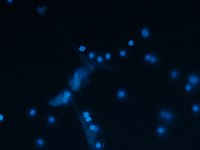
Non‐ST‐elevated myocardial infarction with “N” wave on electrocardiogram and culprit vessel in left circumflex has a risk equivalent to ST‐elevated myocardial infarction
Sign Up to like & getrecommendations! Published in 2020 at "Clinical Cardiology"
DOI: 10.1002/clc.23334
Abstract: It was found that delayed activation wave often appeared in terminal QRS wave in non‐ST‐elevated myocardial infarction (NSTEMI) with culprit vessel in left circumflex artery (LCX), yet little is known about the similarities among non‐“N”‐wave… read more here.
Keywords: culprit vessel; myocardial infarction; elevated myocardial; non elevated ... See more keywords

Calling Critical Troponin Values Using Significant Delta Rises in Serial Draws Instead of a Hard Cutoff to Help Identify Non-ST-Elevated Myocardial Infarction
Sign Up to like & getrecommendations! Published in 2019 at "American Journal of Clinical Pathology"
DOI: 10.1093/ajcp/aqz116.004
Abstract: Non-ST-elevated myocardial infarction diagnoses rely more heavily on lab values. In this study, we examined the effectiveness of an algorithm calculating delta rise in troponins to identify critical values. Using this algorithm in combination with… read more here.
Keywords: values using; troponin values; elevated myocardial; non elevated ... See more keywords

A10648 Progression of left ventricular remodeling from impaired volume growth to increased mass in children elevated myocardial wall stress
Sign Up to like & getrecommendations! Published in 2018 at "Journal of Hypertension"
DOI: 10.1097/01.hjh.0000548811.02956.4b
Abstract: Objectives: To examine the consequences of elevated myocardial wall stress (MWS) in children with and without chronic kidney disease (CKD). Methods: 100 children (10.6 ± 3.0 years) including 66 children with CKD were studied for two visits… read more here.
Keywords: wall stress; myocardial wall; visit; mws ... See more keywords

Prognostic impact of lipoprotein(a) levels during lipid management with statins after ST-elevation acute myocardial infarction.
Sign Up to like & getrecommendations! Published in 2019 at "Coronary Artery Disease"
DOI: 10.1097/mca.0000000000000798
Abstract: The causal relationship of lipoprotein(a) with cardiovascular disease has been established. However, clinical impacts of lipoprotein(a) levels on adverse vascular events in patients with established coronary artery disease who are undergoing statin treatment have not… read more here.
Keywords: statin treatment; lipoprotein levels; elevated myocardial; myocardial infarction ... See more keywords

Impact of bone marrow mononuclear cells therapy on left ventricular function in patients with ST-elevated myocardial infarction
Sign Up to like & getrecommendations! Published in 2018 at "Medicine"
DOI: 10.1097/md.0000000000010359
Abstract: Background: Bone marrow mononuclear cell (BMMNC) therapy has been used as an adjunctive treatment in patients with ST-elevated myocardial infarction (STEMI). However, the therapeutic efficacy of this approach remains controversial. The present meta-analysis is aimed… read more here.
Keywords: patients elevated; myocardial infarction; marrow mononuclear; therapy ... See more keywords

Neutrophil Extracellular Traps Promote Hypercoagulability in ST-Elevated Myocardial Infarction Following Fibrinolytic Administration
Sign Up to like & getrecommendations! Published in 2018 at "Blood"
DOI: 10.1182/blood-2018-99-116105
Abstract: Introduction:Fibrinolysis plays an important role in the treatment of ST-elevated myocardial infarction (STEMI) when percutaneous coronary intervention is not readily available. Early and successful myocardial reperfusion with thrombolytic therapy effectively reduces the infarct size and… read more here.
Keywords: neutrophil extracellular; dna; myocardial infarction; elevated myocardial ... See more keywords

Early kinetics of serum Interleukine-17A and infarct size in patients with reperfused acute ST-elevated myocardial infarction
Sign Up to like & getrecommendations! Published in 2017 at "PLoS ONE"
DOI: 10.1371/journal.pone.0188202
Abstract: Background Recently, it was shown that interleukin-17A (IL-17A) is involved in the pathophysiology of reperfusion injury and associated with infarct size (IS) in experimental models of myocardial infarction. Our aim was to evaluate whether the… read more here.
Keywords: healthy controls; myocardial infarction; infarct size; infarction ... See more keywords

Bone Marrow Mononuclear Cells Transfer for Patients after ST-Elevated Myocardial Infarction: A Meta-Analysis of Randomized Control Trials
Sign Up to like & getrecommendations! Published in 2018 at "Yonsei Medical Journal"
DOI: 10.3349/ymj.2018.59.5.611
Abstract: Purpose Results on the clinical utility of cell therapy for ST-elevated myocardial infarction (STEMI) are controversial. This study sought to analyze the efficacy of treatment with intracoronary bone marrow mononuclear cells (BMMC) on left ventricular… read more here.
Keywords: mononuclear cells; analysis; myocardial infarction; marrow mononuclear ... See more keywords

Human Plasma Transcriptome Implicates Dysregulated S100A12 Expression: A Strong, Early-Stage Prognostic Factor in ST-Segment Elevated Myocardial Infarction: Bioinformatics Analysis and Experimental Verification
Sign Up to like & getrecommendations! Published in 2022 at "Frontiers in Cardiovascular Medicine"
DOI: 10.3389/fcvm.2022.874436
Abstract: The ability of blood transcriptome analysis to identify dysregulated pathways and outcome-related genes following myocardial infarction remains unknown. Two gene expression datasets (GSE60993 and GSE61144) were downloaded from Gene Expression Omnibus (GEO) Datasets to identify… read more here.
Keywords: segment elevated; expression; myocardial infarction; elevated myocardial ... See more keywords